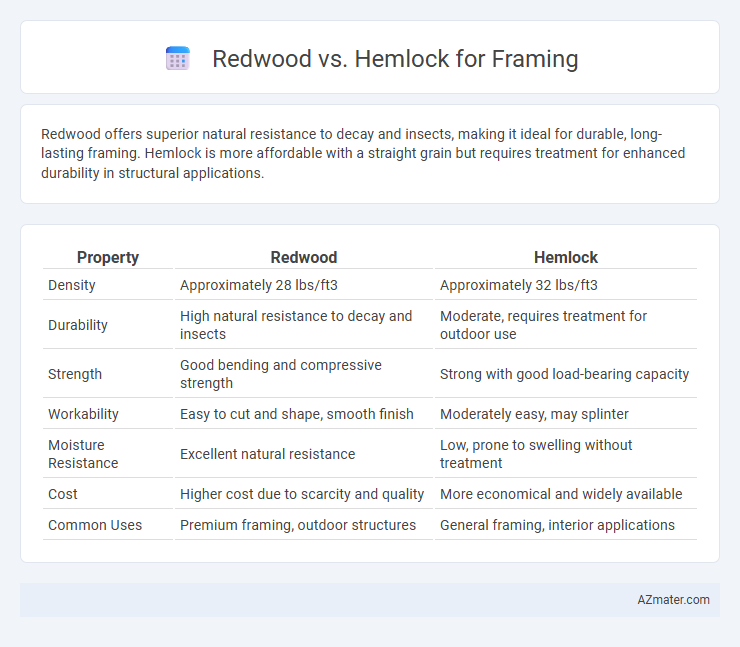Redwood offers superior natural resistance to decay and insects, making it ideal for durable, long-lasting framing. Hemlock is more affordable with a straight grain but requires treatment for enhanced durability in structural applications.
Table of Comparison
| Property | Redwood | Hemlock |
|---|---|---|
| Density | Approximately 28 lbs/ft3 | Approximately 32 lbs/ft3 |
| Durability | High natural resistance to decay and insects | Moderate, requires treatment for outdoor use |
| Strength | Good bending and compressive strength | Strong with good load-bearing capacity |
| Workability | Easy to cut and shape, smooth finish | Moderately easy, may splinter |
| Moisture Resistance | Excellent natural resistance | Low, prone to swelling without treatment |
| Cost | Higher cost due to scarcity and quality | More economical and widely available |
| Common Uses | Premium framing, outdoor structures | General framing, interior applications |
Redwood vs Hemlock: An Overview
Redwood and Hemlock offer distinct advantages for framing, with Redwood prized for its natural resistance to decay and insect damage, making it ideal for outdoor and moisture-prone environments. Hemlock, a softwood common in structural framing, delivers strength and affordability but requires treatment to enhance durability against rot and pests. Choosing between Redwood vs Hemlock depends on project needs like exposure, budget, and longevity requirements.
Wood Strength and Durability Comparison
Redwood offers moderate strength with a Janka hardness of around 450 psi and natural resistance to decay and insects, making it durable for framing purposes. Western Hemlock exhibits higher strength, with a Janka hardness approximately 560 psi, but has less natural decay resistance, requiring proper treatment for enhanced durability. Choosing between Redwood and Hemlock for framing depends on the balance between inherent durability and required structural strength for specific construction needs.
Resistance to Decay and Insects
Redwood offers superior resistance to decay and insects due to its high tannin content, making it a preferred choice for framing in moist or pest-prone environments. Hemlock, while strong and commonly used in construction, lacks the natural preservatives found in redwood, making it more susceptible to fungal decay and insect damage without chemical treatment. Choosing redwood for framing can extend the structural longevity and reduce maintenance costs over time.
Cost Analysis: Redwood vs Hemlock
Hemlock framing typically costs less per board foot compared to redwood, making it a budget-friendly option for large-scale construction projects. Redwood offers superior natural resistance to decay and insect damage, which can reduce long-term maintenance expenses despite its higher upfront cost. Evaluating total cost of ownership, including durability and treatment requirements, is essential to determine the most cost-effective framing material between redwood and hemlock.
Workability and Ease of Installation
Redwood offers excellent workability due to its fine, straight grain and softer texture, making it easier to cut, nail, and shape during framing. Hemlock, while slightly harder and denser, provides solid structural strength but may require more effort and specialized tools for precise installation. Choosing Redwood can reduce labor time and enhance installation efficiency, whereas Hemlock delivers robust framing with a trade-off in ease of handling.
Environmental Impact and Sustainability
Redwood offers superior sustainability due to its natural resistance to decay, reducing the need for chemical treatments and extending the lifespan of framing materials. Hemlock grows faster and is more widely available, promoting efficient forest management and lower environmental impact through responsible harvesting practices. Both woods support carbon sequestration, but sustainably sourced redwood typically has a smaller carbon footprint because of its durability and reduced maintenance requirements.
Availability and Sourcing Options
Redwood is less commonly available in many regions compared to Hemlock, which is widely sourced from North American forests, making Hemlock easier to acquire for framing projects. Hemlock's abundance and sustainable harvesting practices provide a reliable supply chain, whereas Redwood often requires specialized suppliers or imports, increasing lead times and costs. Choosing Hemlock for framing ensures greater availability and consistent quality due to its established sourcing networks.
Aesthetic Qualities and Finishes
Redwood offers rich, warm tones with natural reddish hues and a fine grain that create a visually appealing, rustic finish ideal for visible framing. Hemlock presents a lighter, more uniform color with subtle grain patterns, allowing for versatile staining and smoother finishes that complement modern aesthetics. Both woods accept finishes well, but redwood's natural oils enhance durability and gloss, making it a preferred choice for projects emphasizing beauty and longevity.
Redwood vs Hemlock: Best Uses in Framing
Redwood is highly valued for framing due to its natural resistance to decay, insects, and moisture, making it ideal for outdoor or exposed structures. Hemlock offers a more cost-effective option with excellent strength and stability but requires proper treatment to resist rot and pests. Choosing between redwood and hemlock for framing depends on environmental exposure and budget, with redwood favored for durability and appearance, while hemlock suits less demanding or budget-conscious projects.
Choosing the Right Wood for Your Framing Project
Redwood offers excellent durability and natural resistance to decay and insects, making it a superior choice for framing projects exposed to moisture or outdoor conditions. Hemlock is a cost-effective option with good strength and workability, suitable for interior framing where budget constraints are a priority. Selecting between redwood and hemlock depends on the project's structural requirements, environmental exposure, and long-term maintenance considerations.

Infographic: Redwood vs Hemlock for Framing
 azmater.com
azmater.com